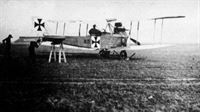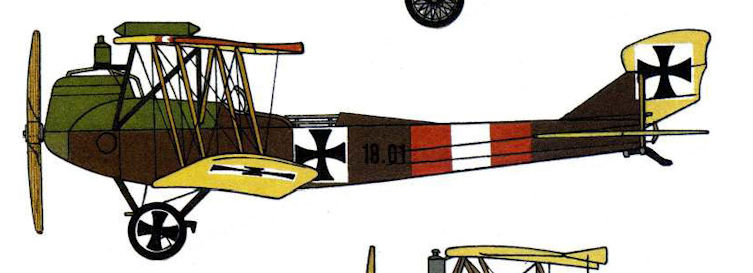В.Кондратьев Самолеты первой мировой войны
ЛЁНЕР B-I/B-II/B-IV/B-VI/B-VII/C-I / LOHNER B-I/B-II/B-IV/B-VI/B-VII/C-I
<...>
Наиболее приемлемым для фронта стал вариант С-I с уменьшенным размахом верхнего крыла. На машине устанавливался двигатель "Австро-Даймлер" мощностью 160 л. с. Новый самолет активно применялся на всех австрийских фронтах в качестве разведчика и даже бомбардировщика. Вооружался одним подвижным пулеметом на турели, кроме того на верхнем крыле в специальной гондоле мог размещаться курсовой пулемет
С начала 1916 года две последние и наиболее совершенные модификации "Лёнера" активно применялись на всех фронтах, где воевали австро-венгерские воздушные силы.
Помимо разведывательных полетов, на счету этих машин немало бомбардировок городов и военных объектов в Румынии, северной Италии и на юго-западной Украине.
МОДИФИКАЦИИ
С-I - двигатель "Австро-Даймлер", 160 л.с., уменьшен размах и упрощена структура крыльев.
ВООРУЖЕНИЕ
Стрелковое: начиная с модификации B-VI на большинство самолетов ставили турельный пулемет "Шварцлозе".
Бомбовое: 80 кг.
ЛЕТНО-ТЕХНИЧЕСКИЕ ХАРАКТЕРИСТИКИ
("Лёнер" C-I)
Размах, м 13,45
Длина, м 9,22
Площадь крыла, кв.м 32,00
Сухой вес, кг 820
Взлетный вес, кг 1360
Скорость максимальная, км/ч 137
Потолок, м 3500
Экипаж, чел 2
P.Grosz, G.Haddow, P.Shiemer Austro-Hungarian Army Aircraft of World War One
Lohner 10.18
The Lohner 10.18 (Type Jc - AE 778) was the first army aircraft designed by Lohner's new chief engineer, Leopold Bauer. It was created to meet the armed two-seater (military class C) specification issued in late 1915. As might be expected, the 10.18 had little in common with its predecessors. The fuselage was plywood-covered, the wing cellule simplified, and the sweepback greatly reduced. Extant records show that the 10.18, powered by a 185 hp Daimler engine, was assembled at Aspern on 4 January 1916, ready for flight on 20 January, and test pilot Karl Kriger performed the maiden flight on 5 February 1916.
Having completed tests as the prototype for the Lohner C.I series 18 production aircraft, the 10.18 temporarily was fitted with a 140 hp Rapp V-8 engine to evaluate the engine for use in the Lohner B.VI series 16.1 biplane. In August 1916, the 10.18, once again powered by a 185 hp Daimler engine, was assigned to the aircraft test group at Aspern for training and experimental purposes.
Lohner C.I Series 18
With the conclusion of the Lohner 10.18 evaluation trials, Lohner signed a contract on 10 March 1916 for 24 C.I biplanes (Type Jc) powered by a 160 hp Daimler engine. Parts manufacture had begun in December 1915 and delivery was scheduled to start on 5 April and end in July 1916. Flars stopped delivery in June 1916 because, compared with the Brandenburg C.I, the first production machines demonstrated "hopelessly inadequate" performance even after the contractual flight specifications had been lowered. Lohner, unable to rectify the shortcomings, was obliged to pay a penalty. After a long delay, Flars accepted a total of 23 C.I biplanes numbered 18.01 to 18.23.71 Unsuitable for frontline service, the C.I machines were used as trainers by Fleks 1, 4-9, 11, and 14 and Schulkompagnie 2. In November 1917, nine damaged aircraft were dispatched to Flugpark 1 for disposal, but a few remained in training service until mid-1918.
Lohner C.I Series 18 Specifications
Engine: 160 hp Daimler
Wing: Span Upper 12.80 m (41.99 ft)
Span Lower 12.10 m (39.70 ft)
Chord Upper 1.78 m (5.84 ft)
Chord Lower 1.78 m (5.84 ft)
Sweepback Upper 8.5 deg
Gap 1.90 m (6.23 ft)
Stagger 0.26 m (0.85 ft)
Total Wing Area 38.45 sq m (414 sq ft)
General: Length 9.25 m (30.35 ft)
Height 3.30 m (10.83 ft)
Track 2.05 m (6.73 ft)
Empty Weight 869 kg (1916 lb)
Loaded Weight 1333 kg (2939 lb)
Maximum Speed: 132 km/hr (82 mph)
Climb: 1000m (3,281 ft) in 7 min 56 sec
Lohner C.I Series 18.5
On 22 September 1916, a contract was signed for 17 improved Lohner C.I biplanes (Type Jcr) numbered 18.51 to 18.67. Flight evaluation was performed with aircraft 18.24 that was modified to Type Jcr standard and reportedly renumbered 18.51. The Type Jcr, powered by a 160 hp Daimler engine, was fitted with a new wing cellule and lightened throughout, resulting in improved but still mediocre performance. The series 18.5 machines were flown as trainers by Fleks 3, 5, 7, 9, 12, and 13. In March 1917, aircraft 18.61 to 18.64, additionally armed with a Type VK II machine gun canister, were pressed into home-defense duty with the Flars Versuchsflik (test squadron) at Aspern. As of July 1917, thirty- six C.I aircraft were listed on training status, perhaps not all in flying condition.
Lohner C.I Series 18.5 Specifications
Engine: 160 hp Daimler
Wing: Span Upper 12.44 m (40.81 ft)
Chord Upper 1.78 m (5.84 ft)
Chord Lower 1.78 m (5.84 ft)
Sweepback Upper 8.5 deg
Gap 1.90 m (6.23 ft)
Stagger 0.26 m (0.85 ft)
Total Wing Area 43.3 sq m (465 sq ft)
General: Height 3.00 m (9.84 ft)
Empty Weight 759 kg (1674 lb)
Loaded Weight 1216 kg (2681 lb)
Maximum Speed: 134 km/hr (83 mph)
Climb: 1000m (3,281 ft) in 5 min 37 sec
2000m (6,562 ft) in 12 min 45 sec
3000m (9,843 ft) in 22 min 56 sec
E.Hauke, W.Schroeder, B.Totschinger Die Flugzeuge der k.u.k. Luftfahrtruppe und Seeflieger 1914-1918
10. Flugzeuge der Fabrik Jacob Löhner & Co.
10.18 Löhner DD Type JC Dm 160
18.01 - 18.23 Löhner C.I (Type JC) Dm 160
18.51 - 18.67 Löhner C.I (U) Dm 160
 |
E.Hauke, W.Schroeder, B.Totschinger - Die Flugzeuge der k.u.k. Luftfahrtruppe und Seeflieger 1914-1918
|
| Löhner C I 18.01 1916
|
 |
E.Hauke, W.Schroeder, B.Totschinger - Die Flugzeuge der k.u.k. Luftfahrtruppe und Seeflieger 1914-1918
|
| Lohner C.I
|
 |
P.Grosz, G.Haddow, P.Shiemer - Austro-Hungarian Army Aircraft of World War One /Flying Machines/
|
| The Lohner 10.18 during flight tests at Aspern in February 1916. A distinct departure from the Pfeilflieger, the 10.18 represented chief engineer Bauer’s first landplane design for Lohner.
|
 |
E.Hauke, W.Schroeder, B.Totschinger - Die Flugzeuge der k.u.k. Luftfahrtruppe und Seeflieger 1914-1918
|
| Löhner C.I, 18.15
|
 |
P.Grosz, G.Haddow, P.Shiemer - Austro-Hungarian Army Aircraft of World War One /Flying Machines/
|
"Лёнер" С-I Компоновка фюзеляжа Лёнера СI, как и многих других австрийских самолетов, копировала популярный Ганза-Бранденбург СI
The Lohner C.I series 18 (Type Jc), the first landplane designed by Leopold Bauer, failed to meet the performance requirements and was placed in service as a trainer. Aircraft 18.23 was attached to Flek 7 until written-off after a crash in May 1918.
|
 |
P.Grosz, G.Haddow, P.Shiemer - Austro-Hungarian Army Aircraft of World War One /Flying Machines/
|
| Lohner C.I 18.52. Outwardly identical to the series 18, the C.I series 18.5 (Type Jcr) aircraft had a new wing cellule and lightened airframe but also proved unsuitable for frontline use and finished the war as a trainer with Flek 12.
|
 |
P.Grosz, G.Haddow, P.Shiemer - Austro-Hungarian Army Aircraft of World War One /Flying Machines/
|
| A few Lohner C.I series 18 and 18.5 aircraft served to evaluate new equipment. Here a “Wolf” exhaust silencer is being tested on aircraft 18.63.
|
 |
P.Grosz, G.Haddow, P.Shiemer - Austro-Hungarian Army Aircraft of World War One /Flying Machines/
|
| Sitting in a well-padded ‘easy chair’, the pilot of the Lohner C.I 18.23 was confronted (underneath the coaming right to left) by an altimeter, manometer, engine water manometer (below), fuel switch and hand pump switch and lever. Several other instruments are not visible. The tachometer is mounted on the windshield.
|
 |
В.Кондратьев - Самолеты первой мировой войны
|
| "Лёнер" С-I
|
 |
P.Grosz, G.Haddow, P.Shiemer - Austro-Hungarian Army Aircraft of World War One /Flying Machines/
|
| Lohner C.I Series 18
|











